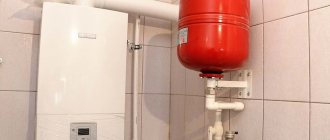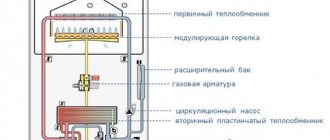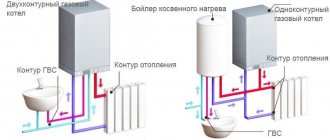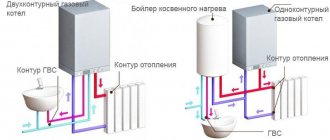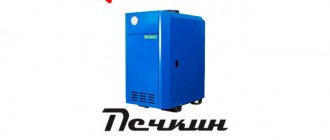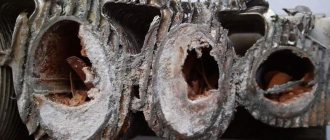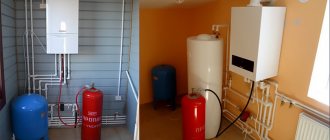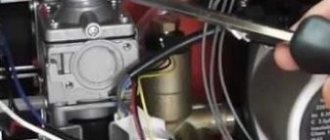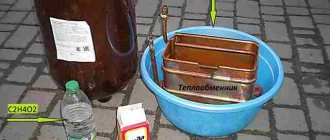The hot water supply system in your home can be organized in different ways. Fortunately, manufacturers today offer various options. The easiest way is to install a hot water gas boiler, which will heat water in its tank to the required temperature. True, this is not the most economical option, so there are better ways. For example, you can install a gas boiler with a boiler. What is it and how does it all work?
The lineup
Let's start with the fact that there are two models that work using the same technology, but the boiler itself is located differently:
- Models with a free-standing boiler.
- With built-in reservoir.
First option
For this, a separate gas boiler and a separate boiler are purchased. Here it is very important to accurately correlate the boiler power with the volume of the container. It may happen that the performance of a gas boiler is not enough to heat the water inside the boiler to a certain temperature (often up to +60°C) in a short period of time. This means you will not receive either hot water or an efficient heating system. Why?
It's all about the principle of operation of wall-mounted or floor-standing gas boilers with a boiler. It turns out that the coolant, heating up inside the boiler, is redistributed as needed. If the temperature of water for household needs inside the boiler corresponds to the programmed indicator, then the coolant works for the heating system. As soon as the temperature becomes lower, it is immediately redistributed to the DHW system. That is, the supply of coolant to the heating system is immediately turned off. This means the temperature in the house becomes lower.
Floor-standing with boiler
Attention! The larger the boiler volume you choose, the higher the likelihood that when the coolant is redistributed, the temperature in the house will always be lower than necessary. That is why we already said above that it is necessary to accurately correlate two indicators: the power of the heating unit and the volume of the boiler.
Currently, manufacturers offer two options for this type of boiler:
- Single-circuit with a separate hot water tank.
- Dual-circuit.
In the first case, these are floor-standing gas boilers with high power. In the second, these are wall structures. And here the question arises, which one to choose? It all depends on how much area you have to heat. If this is an apartment or a small country house (dacha), then the second option. If this is a large private house, then only the first one. But keep in mind that each type has its own advantages and disadvantages.
With built-in boiler
For example, a double-circuit gas boiler with a boiler has a heat exchanger with a small cross-section, that is, with a small cross-section. This is a minus. In addition, salt and mud deposits quickly settle in them, which means they will have to be washed and purged more often. In addition, maintenance of a single-circuit boiler and the boiler itself is simpler; in fact, the consumer receives a kind of central network through which the coolant flows, used for both heating and domestic hot water.
Second option
Gas boilers with a built-in boiler are double-circuit wall-mounted models, where part of the thermal energy is spent on heating water inside the tank, which is built into the body of the boiler itself. So to speak:
- The built-in tank complicates and enlarges the design.
- The tank volume is not very large. There is both a plus and a minus here. Plus - quick heating of a small amount of water located in the boiler, and, therefore, a reduction in heat costs. The downside is a small amount of hot water, which may last for a few minutes.
- Typically, double-circuit wall-mounted units are equipped with a complex automation system. There are pros and cons here too. Pros - boilers operate efficiently and economically. Cons: the automation itself is very capricious and often breaks down.
Boiler and boiler wiring diagram
On the Russian market, wall-mounted gas boilers with a built-in boiler are not very popular. Our compatriots are trying to purchase units that create the least problems with their operation. Complex temperature settings, all kinds of switching, monitoring pressure and temperature - all this irritates us. Therefore, Russians choose more simplified designs. And here a boiler (wall-mounted or floor-mounted) with a separate boiler is the optimal solution.
How to make a harness without errors?
In order for both units - both the gas boiler and the BKN - to operate without failure and throughout their entire service life, it is important to properly perform the piping, that is, install the safety group and other elements.
Image gallery
Photo from
Expansion tank for boiler
Maintenance drain valve
Air vent for removing air pockets
Hot water circulation pump
When installing coarse filters, be sure to check its location - there is an arrow on the body indicating the direction of water movement.
Such a filter cannot be installed vertically, since as a result, coarse particles accumulate in the pipe and not in the filter itself. Cleaning can only be done by pressure washing - this way you can dirty the entire boiler room.
The expansion tank must not be installed separately, but between the boiler and the check valve, otherwise it will be useless and will not perform its functions.
Other options
We talked above about storage-type structures. That is, the water in the tank has a certain volume, which heats up. But there are also flow-type models on the market. In them, water is heated to a certain temperature as it moves through a special heat exchanger.
Typically, the heat exchanger is made of a material with high thermal conductivity and good corrosion resistance. Therefore, this unit is most often made of copper, aluminum or stainless steel. But their shape is coiled, because you have to install a heat exchanger of quite a long length in a small volume. And the longer it is, the more efficiently it heats the water. By the way, water heating gas boilers, which were already mentioned above, operate using this system.
Simple connection diagram
Boiler location in the house
Floor-mounted models are installed in a specially equipped room. You can use the utility room for this. Floors must be non-flammable. If the device is equipped with a built-in burner, it cannot be replaced in case of breakdown. Blowing configurations are more profitable - you need to purchase them yourself, but they can be easily replaced at home.
A hanging boiler does not require a special room and can be installed, for example, in the kitchen. Compact dimensions allow you to place it in a niche in the wall or in a small closet.
Advantages of single-circuit boilers with a boiler
So, we have established that single-circuit gas boilers with a separate boiler are considered the most popular today. Therefore, there is a need to outline all its advantages:
- Large internal cross-section of the heat exchanger. This helps reduce scale formation. Unfortunately, the quality of water used in domestic water supply systems leaves much to be desired.
- High reliability indicator, which is determined by the simplicity of the design of the device itself.
- In this model, the consumption of thermal energy is more rational, and, therefore, this is the reason for the high efficiency and savings in fuel consumption.
- The water inside the boiler almost always has a certain temperature. It is not affected by pressure surges inside the gas line or temperature surges inside the heating system of the house.
- Ease of maintenance, where it is necessary to note a minimum of automation devices.
- The entire set (gas boiler plus boiler) consistently provides hot water to your home, regardless of the time of day. In addition, the heating also works stably.
- Simple built-in automation will help you set the necessary parameters for hot water in the DHW system and coolant in the heating system. She also controls these parameters.
Boilers
A few words about boiler performance
When choosing a boiler, it is important to correctly assess its performance. Often the manufacturer indicates only the initial performance, which is taken into account when the hot water tank is full. For the consumer, it is more important to take into account the performance that the boiler produces with regular water consumption. This figure is significantly lower than the original performance.
Another important point that affects performance is the temperature increase. The lower this indicator, the longer the boiler will work, and the fewer breakdowns there will be. When indicating boiler performance, manufacturers rely on various growth data. In general, you should adhere to the rule: the greater the power of the equipment and the volume of the boiler, the more productive the equipment.
More information about choosing a gas heating boiler is presented in the video:
We present to your attention an online calculator for selecting a boiler depending on the characteristics of your premises:
Connecting a boiler to a water supply system made of different materials
The boiler is connected to a heat supply system using both traditional steel pipes and more modern polypropylene and metal-plastic pipes.
A cheaper option is polypropylene. The choice will depend on the price of the project and the operating temperature of the heating fluid at the outlet of the boiler. For example, in a solid fuel boiler, the coolant temperature is difficult to regulate; there may be cases where it will spontaneously rise to 100 C, so in this case it is better to install steel pipes.
Although they are less durable, they are designed for the high temperature operating conditions of solid fuel devices.
Polypropylene pipelines
Polypropylene pipes are easily installed using a specialized soldering iron and scissors for cutting pipelines. After selecting the connection point, a section in the pipeline is cut out in width equal to the tee, with a deduction of 20 mm: 10 mm for each.
Using a soldering iron, heat the pipe and fitting to the required technical condition and connect them. At the same time, it is forbidden to scroll them, since this can disrupt the tightness of the connection.
Next, connecting parts of pipes of various lengths and angles, a connection is made to the BKN nozzles. A threaded coupling is soldered to the end of the pipe section and then the entire line is firmly connected.
Insertion into a metal pipeline
Today, it is possible to connect the BKN to water supply utilities without the use of welding; for this, there is a modern “vampire” adapter device, which has a technological hole and a clamp in the body. Installation of this design is very simple. Select a cutting point and clean the area.
A clamp with a heat-resistant gasket is installed on top of the prepared area and tightened with bolts to secure it. Next, turn off the water supply and drain it from the desired section of the pipeline by opening the hot water tap on the mixer.
Next, the pipe section is drilled through the hole in the clamp with an electric drill and then the valve is screwed on and the BKN piping is continued according to the diagram.
Metal-plastic
This is the most reliable and simplest option for connecting a BKN boiler to a double-circuit boiler. The metal-plastic material is simply bent to the desired outlet angle, and the connections of the nodes are made with various crimp fittings.
Before tying the BKN, the pipe is cut to the required length and size. Next, select the insertion point, taking into account the size of the tee and the part of the pipe that will be occupied by the connection.
To prepare a hole in a small area, special scissors are used. The nuts are removed from the tee and, together with the fixation rings, they are put on different ends of the pipe. Flare the ends of the metal-plastic using a special calibrator or screwdriver.
The tee is inserted all the way, then the rings are moved and the nuts are tightened with a wrench. You can also use fittings for metal-plastic pipes, which will require crimping and additional specialized tools and devices.
Calculation of the required boiler power
When calculating power, the area of the house, the number of windows, the degree of wall insulation, and climate are taken into account
. Before purchasing, it is important to calculate the optimal thermal performance indicator. The roughest method is based on the area of the home: it is assumed that 1 kW of power is needed to service every 10 m2 (if the height of the room does not exceed 3 m) and 20-30% of the reserve is added to the resulting result. However, the situation is influenced by a number of factors that are not taken into account in this method: climate, sources of heat loss, the amount of heated water consumed, installations of forced circulation of air masses.
A more accurate calculation will be obtained if you enter into the formula a specific coefficient determined by climatic conditions: for the south of the CIS it will be equal to 0.7-0.9, for the central region of the European part of Russia - 1-1.1, for the northern regions 1.3- 1.4. Then the formula will take the form: N=S*k/10, where N is power in kW, S is area in m2, k is coefficient. If a boiler is purchased for heating and water supply at the same time, the resulting result is multiplied by 1.25.
Distinctive features of an indirect heating boiler
A boiler is a large barrel whose main function is storage. It comes in different volumes and shapes, but its purpose does not change. Without a boiler, a problem may arise when using, for example, two showers or a shower and a kitchen tap at once.
If a household 2-circuit boiler with a power of 24-28 kW produces only 12-13 l/min per flow, and one shower requires 15-17 l/min, then when any additional tap is turned on, there will be a shortage of water supply. The boiler simply does not have enough working capacity to provide hot water to several points.
If a large storage tank is installed in the house, even with several water points turned on at the same time, everyone will be provided with hot water
All storage boilers can be divided into 2 large categories:
- direct heating, creating a supply of hot water using a heating element - for example, an electric heating element;
- indirect heating, heating water with already hot coolant.
There are other types of boilers - for example, conventional storage water heaters. But only volumetric storage devices can indirectly receive energy and heat water.
BKN, unlike energy-dependent equipment running on electric, gas or solid fuel, uses the heat generated by the boiler. Simply put, it does not require additional energy to function.
BKN design. Inside the tank there is a coil - a steel, brass or copper tubular heat exchanger that acts as a heating element. Heat inside the tank is retained according to the principle of a thermos
The storage device fits easily into the DHW system and does not cause problems during operation.
Users see many advantages in using BKN:
- the unit does not require electrical power and benefits from the economic side;
- hot water is always “ready”, there is no need to let cold water pass through and wait for it to heat up;
- Several water distribution points can operate freely;
- stable water temperature that does not drop during consumption.
There are also disadvantages: the high cost of the unit and additional space in the boiler room.
The volume of the storage tank is chosen based on the number of people permanently residing in the house. The smallest boilers are designed for 2 consumers, so when choosing, you can start from a volume of 50 liters
According to all characteristics, the BKN is suitable for use in conjunction with a gas boiler. Moreover, this is one of the best solutions for equipping a hot water preparation system for a private house with a large number of residents.
But boilers are different, so we will consider both acceptable options and those where problems may arise.
Installation principle
If you need to mount a tank with a capacity of up to 200 liters, this can be a wall-mounted product. For its fastening, special kind of brackets are provided, which must be located on flat and strong vertical surfaces. Conventional plasterboard partitions are of little use for mounting even such a “light” storage device. You need to choose between saving on the arrangement of interior space and saving on the boiler. Floor-standing units are preferred to meet the needs of large households; sometimes they even install products with a capacity of over a thousand liters and allocate a special boiler room for them.
In private homes, you can limit yourself to indirect heating boilers that accumulate from 250 to 300 liters of water. The exact choice of capacity must be made taking into account real and projected needs. When connected to a double-circuit boiler equipped with a built-in pump, the boiler automation itself takes over the coordination of the valve operation based on signals from the thermostat
This is very important because a double-circuit heating device, unlike a single-circuit heating device, must supply hot liquid both to the heating system and to the hot water supply circuit
If you install a three-way valve, the water heater will have an advantage in the system compared to the heating circuit. This approach is acceptable when a large capacity tank is installed. Please note: this connection method is also practiced when forced to use hard water, which complicates the normal use of the hot water system. Although, of course, it would be much more correct to take care of softening the incoming coolant. But sometimes you have to adapt to it against your will.
Problems may arise due to the fact that significant consumption of hot water can complicate the functioning of this circuit. In this case, the method of obtaining heat, including using a pellet or other solid fuel boiler, is not significant. And this is where the boiler comes to the rescue, smoothing out fluctuations in two circuits. Thanks to it, even intensive coolant consumption has little impact on people’s daily lives. Installers must consider which function will have the highest priority.
Connecting indirect heating boilers to a single-circuit boiler can be done using a pair of pumps. Then, with their help, water flows are distributed through two pipelines. It is usually assumed that the hot water supply circuit will come first. The operation algorithm of the boiler in conjunction with a single-circuit device is also adjusted accordingly. To prevent liquid flows of different heating levels from changing each other’s basic parameters, both pumps must be preceded by a return valve. Hot water is supplied exclusively from the boiler.
Types of gas boilers
Gas devices with an indirect heating boiler may differ in the type of placement and shape of the tank.
According to the principle of placement: wall and floor
Can be:
- wall;
- floor
Units of the first category are devices of small volume - up to two hundred liters.
A floor-standing gas boiler in a package, with an indirect heating boiler, is installed in a special room.
They are installed using special brackets on a stable wall that can support the weight of the water tank without loss. It is clear that flimsy plasterboard partitions are not suitable for this purpose. Typically, such devices are purchased by one small family for their private home.
The second ones are capacious water heaters designed for a large number of people. Such devices will require the installation of a special boiler room.
They are usually purchased by enterprises and owners of large cottages and estates.
According to the shape of the tank
- Horizontal: very bulky, but they do not require pumps; they themselves maintain the water in the required volume.
- Vertical: have a small capacity.
When choosing, you should take into account the number of people in the family, as well as the layout features and the availability of free space in the country house or in the house.
Gas floor-standing boiler installed in the boiler room and a small vertical expansion tank.
